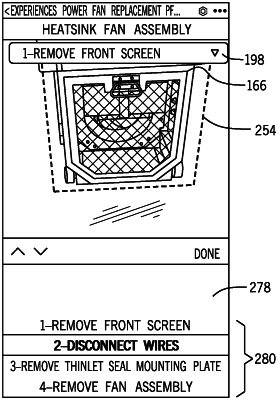| CPC G05B 19/0425 (2013.01) [G05B 19/4183 (2013.01); G05B 19/4185 (2013.01); G05B 19/41875 (2013.01); G05B 19/41885 (2013.01); G06F 3/04815 (2013.01); G06T 19/006 (2013.01); G05B 2219/32014 (2013.01)] | 20 Claims |

|
1. A system, comprising:
a processor; and
memory comprising computer-executable code that, when executed by the processor, causes the processor to:
receive a service request from a first device, wherein the service request is configured to cause a computing system to communicatively couple the first device to a second device;
transmit a workflow dataset associated with an industrial automation device to the first device and the second device, wherein the workflow dataset comprises:
one or more instructions associated with one or more operations for the industrial automation device; and
one or more virtual objects associated with the one or more instructions and the industrial automation device, wherein the one or more virtual objects are configured to:
be rendered at a first position and orientation in a first augmented environment of first image data depicted on a first display of the first device, wherein the first position and orientation are relative to a first location of the industrial automation device in a real-world environment; and
be rendered at a second position and orientation in a second augmented environment of second image data depicted on a second display of the second device, wherein the second position and orientation are relative to the first location of the industrial automation device in the real-world environment;
wherein the workflow dataset is configured to cause the first device and the second device to display an animation of a first virtual object of the one or more virtual objects on the first image data depicted on the first display and the second image data depicted on the second display, respectively, and wherein the animation corresponds to performing a first instruction of the one or more instructions;
receive an input to the second image data representative of the animation from the second device, wherein the input comprises one or more visualizations at a third position and orientation in the second augmented environment;
determine a fourth position and orientation within the first augmented environment based on the third position and orientation and the first position and orientation;
generate an indication of directional haptic feedback based on the fourth position and orientation, wherein the indication of directional haptic feedback comprises a pulse intensity configured to convey a directional notification for a user of the first device, wherein the directional notification is indicative of a direction relative to the user;
transmit the one or more visualizations to the first device for display via the first display;
transmit the indication of directional haptic feedback to the first device, wherein the indication of the directional haptic feedback is configured to cause the first device to output the directional haptic feedback using the pulse intensity, wherein the first device is configured to:
receive third image data representative of the industrial automation device from an image sensor associated with the first device;
determine that the first instruction of the one or more instructions is not performed based on a comparison between the third image data and the animation corresponding to first virtual object performing the first instruction; and
present a notification indicative of an incorrect performance of the first instruction via the first display in response to determining that the first instruction was not performed.
|